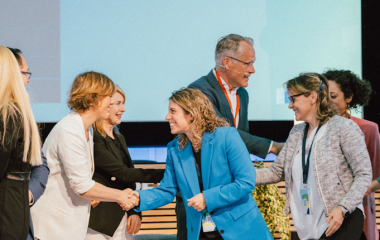
Photo: Selma Jahić from Partner (GGF)
Share
Share
With the assistance of the Green for Growth Fund (GGF), Partner is enabling clients to improve energy efficiency and cut air pollution. It became one of the largest microlenders in Bosnia and Herzegovina.
Through 5,000 microloans, Partner has helped its clients in BiH insulate their homes and reduce air pollution, energy consumption and energy costs, and improve lives across the country. The GGF has been supporting the microfinance provider for more than a decade.
Partner has been providing financial services to communities with difficult or no access to commercial funding sources and supporting the development of businesses. It has provided over EUR 29 million in microloans to homes and small businesses, and increased its rural client base by 20%.
Investors and lenders outside the EU can future-proof their businesses by aligning now with stricter EU regulations
After realizing the untapped business potential in rural communities, Partner is now one of the largest microfinance institutions in the country, with over 60 offices.
In Bosnia and Herzegovina, over 75% of primary energy is supplied by fossil fuels, of which the housing sector consumes around 40%. Most electricity is produced in thermal power plants, with most private households heating their homes with coal. This has led to rising air pollution throughout the country.
Comprehensive approach in credit lines, risk management
By developing the Home Energy credit line for customers and setting up a risk management system for the loans, Partner has boosted its portfolio growth and gained a competitive edge. The borrowers also have major benefits: they have more efficient and cleaner heating, which is easier to use.
Partner is buoying primary energy savings and reducing CO2 emissions by educating potential clients and implementing measures on individual housing
GGF said it has demonstrated through the collaboration how green finance can help institutions reach a broader client base and ensure sustainable portfolio growth, whilst enabling widespread, positive environmental impact. The fund has an open invitation for anyone who wants to start a Green Journey.
In 2012, Partner found an ally in the Green for Growth Fund, which, in addition to financial resources, also provided the technical assistance necessary to launch such a pioneering project, Director of Support Selma Jahić said. “By educating potential clients and implementing measures on individual housing, we are making a significant impact on primary energy savings and reducing CO2 emissions at the national level. None of this would be possible without good and reliable partners like GGF, and we look forward to continuing the cooperation in the years to come.”
Green makeovers strengthen lenders, companies
Making green improvements makes both banks and businesses more resilient, as borrowers are less likely to be impacted by climate transition risks, and are hence more reliable in terms of repayments.
While banking institutions in the European Union must already comply with the existing regulatory framework for greening finance, those in neighboring nations stand to benefit from adopting a green strategy now. Investors and lenders outside the EU can future-proof their businesses by aligning now with stricter EU regulations.
The GGF was launched in 2009 by Germany’s KfW Development Bank and the European Investment Bank (EIB), with financial support from the European Commission, German Federal Ministry for Economic Cooperation and Development (BMZ), European Bank for Reconstruction and Development (EBRD) and Austrian Development Bank (OeEB).
Last year the facility mobilized EUR 135 million in investments and technical assistance commitments, increasing the portfolio to over EUR 1.1 billion and more than 40,000 end-borrowers. The funds were dedicated to financing measures that boost a green recovery and advance energy efficiency, renewable energy and resource efficiency in Southeast Europe, Turkey, the EU’s eastern neighbors, the Middle East and North Africa.


















Be the first one to comment on this article.